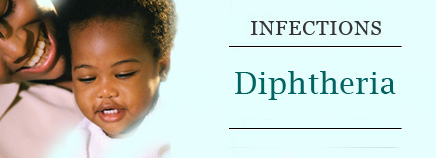
About Diphtheria
Diphtheria is a bacterial infection that spreads easily and occurs quickly. It mainly affects the nose and throat. Children under 5 and adults over 60 years old are particularly at risk for contracting the infection. People living in crowded or unclean conditions, those who aren’t well nourished, and children and adults who don’t have up-to-date immunizations are also at risk.
Diphtheria is very rare in the United States and Europe, where health officials have been immunizing children against it for decades. However, it’s still common in developing countries where immunizations aren’t given routinely. In 1993 and 1994, more than 50,000 cases were reported during a serious outbreak of diphtheria in countries of the former Soviet Union.
Signs and Symptoms
In its early stages, diphtheria can be mistaken for a bad sore throat. A low-grade fever and swollen neck glands are the other early symptoms.
The toxin, or poison, caused by the bacteria can lead to a thick coating (or membrane) in the nose, throat, or airway, which makes a diphtheria infection different from other more common infections that cause sore throat (such as strep throat). This coating is usually fuzzy gray or black and can cause breathing problems and difficulty in swallowing.
As the infection progresses, someone may:
- have difficulty breathing or swallowing
- complain of double vision
- have slurred speech
- even show signs of going into shock (skin that’s pale and cold, rapid heartbeat, sweating, and an anxious appearance)
In cases that progress beyond a throat infection, diphtheria toxin spreads through the bloodstream and can lead to potentially life-threatening complications that affect other organs, such as the heart and kidneys. The toxin can cause damage to the heart that affects its ability to pump blood or the kidneys’ ability to clear wastes. It also can cause nerve damage, eventually leading to paralysis. Up to 40% to 50% of those who don’t get treated can die.
Prevention
Preventing diphtheria depends almost completely on giving the diphtheria/tetanus/pertussis vaccine to children (DTaP) and non-immunized adolescents and adults (Tdap). After a single dose of Tdap, adolescents and adults should receive a booster shot with the diphtheria/tetanus vaccine (Td) every 10 years. Most cases of diphtheria occur in people who haven’t received the vaccine at all or haven’t received the entire course.
The Tdap vaccine is also recommended for all pregnant women during the second half of each pregnancy, regardless of whether or not they had the vaccine before, or when it was last given.
The immunization schedule calls for:
- DTaP vaccines at 2, 4, and 6 months of age
- booster dose given at 12 to 18 months
- booster dose given again at 4 to 6 years
- Tdap vaccine given at 11-12 years
- booster shots of Td given every 10 years after that to maintain protection
- Tdap vaccine during the second half of each pregnant woman’s pregnancy
Although most children tolerate it well, the vaccine sometimes causes mild side effects such as redness or tenderness at the injection site, a low-grade fever, or general fussiness or crankiness. Severe complications, such as an allergic reaction, are rare.
Contagiousness
Diphtheria is highly contagious. It’s easily passed from an infected person to others through sneezing, coughing, or even laughing. It also can spread to someone who picks up tissues or drinking glasses that have been used by an infected person.
People infected with the diphtheria bacteria, even if they don’t have any symptoms, can infect others for up to 4 weeks. The incubation period (the time it takes for a person to become infected after being exposed) for diphtheria is 2 to 4 days, although it can range from 1 to 6 days.
Treatment
Children and adults with diphtheria are treated in a hospital. After a doctor confirms the diagnosis through a throat culture, the infected person receives a special anti-toxin, given through injections or an IV, to neutralize the diphtheria toxin already circulating in the body, plus antibiotics to kill the remaining diphtheria bacteria.
If the infection is advanced, people with diphtheria may need a ventilator to help them breathe. In cases in which the toxins may have spread to the heart, kidneys, or central nervous system, patients may need intravenous fluids, oxygen, or heart medications.
A person with diphtheria must be isolated. Family members and other close contacts who haven’t been immunized, or who are very young or elderly, must be protected from contact with the patient.
When someone is diagnosed with diphtheria, the doctor will notify the local health department and treat everyone in the household who may have been exposed to the bacteria. Treatment includes assessment of immune status, throat cultures, and booster doses of the diphtheria vaccine. They will also receive antibiotics as a precaution.
Immediate hospitalization and early intervention allow most patients to recover from diphtheria. After the antibiotics and anti-toxin have taken effect, someone with diphtheria will need bed rest for a while (4 to 6 weeks, or until full recovery). Bed rest is particularly important if someone develops myocarditis (inflammation of the heart muscle), which can be a complication of diphtheria.
Those who have recovered should still receive a full course of the diphtheria vaccine to prevent a recurrence because contracting the disease doesn’t guarantee lifetime immunity.
When to Call the Doctor
Call your doctor immediately if anyone in your family has symptoms of diphtheria, if you observe symptoms in someone else, if anyone in your family is exposed to diphtheria, or if you think that you or a family member is at risk. It’s important to remember, though, that most throat infections are not diphtheria, especially in countries that have routine immunizations against it.
If you’re not sure if your kids have been vaccinated against diphtheria, make an appointment. Also make sure your own booster immunizations are current. International studies have shown that a significant percentage of adults over 40 years of age aren’t adequately protected against diphtheria and tetanus.

